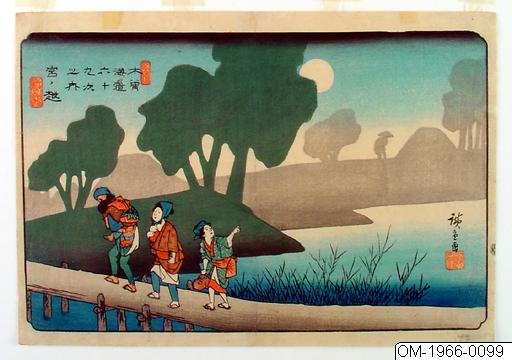OM-1966-0099
::
träsnitt, bildkonst

- Object description
Två kvinnor och en man på en bro, resande på Kisokaido-vägen. En man bär ett äldre barn medan en kvinna bär en baby och en annan bär saker i en furoshiki (omslagstyg).
Miyanokoshi. Station 37 ur serien: De sextionio stationerna längs Kisokaido. (The Sixty-Nine Stations of the Kisokaido, Kisokaido rokujuku tsugi). 1834-1842. Flerfärgsträsnitt (nishiki-e), oban-format. /PH
Ichiryusai Hiroshige 1797-1858.
Kisokaido, station nr 37, Miyanokoshi. ca 1840.
TEMP-1180?
Kisokaido, eller Nakasendo (”väg som passerar genom de centrala bergen”), som den officiellt heter, var en av Edo-periodens fem största vägar medan namnet Kisokaidō syftar på Kiso-floden som vägen delvis följde. Liksom Tokaido (den största vägen)kopplade den samman Edo och Kyoto men inte längs kusten som Tokaido utan i inlandet. Vägens sträckning har delvis sitt ursprung ända tillbaka till 700-talet. Vägen var inte alls lika populär som Tokaido, mycket på grund av dess mer riskabla passager. Därför dokumenterades sträckan inte lika mycket i reseberättelser och guideböcker, eller bilder för den delen. Hiroshige producerade dock en serie baserad på sträckan tillsammans med Keisai Eisen (1789 - 1851). /PH



 Important to know about the information in the online collection database
Important to know about the information in the online collection database
Leave a comment
Here you can leave a comment. You have to supply an e-mail, an alias and you have to approve the conditions.